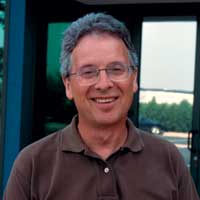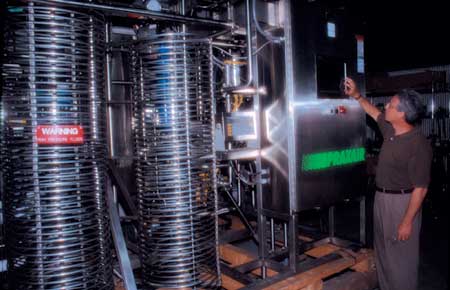

A relatively new technique is pressurized dense-phase liquid carbon dioxide, a method for inactivating enzymes in food products by creating a carbonic acid solution.
A team of food scientists at the University of Florida in Gainesville began developing the process 15 years ago. This fall, Praxair Inc. expects to unveil Better than Fresh™, a beverage treatment system that represents the technology’s first commercial application.
Jacob E. Eisenwasser, a chemical and metallurgical engineer, has headed the engineering effort at Praxair’s R&D center in Burr Ridge, Ill., to move pressurized CO2 treatment out of the laboratory and into juice plants. As construction of the first commercial units was concluding, Eisenwasser discussed that process and the hurdles that had to be overcome.
FE: When did your involvement in this project begin?
Eisenwasser: After Praxair licensed the process from the University of Florida, we assembled a team of engineers and food scientists and built a bench scale prototype in 1998. The preliminary results were very encouraging. We began to build a database of knowledge using surrogate pathogens to establish kill rates. Eventually the system was validated for effectiveness against real pathogens at the National Center for Food Science and Technology, which served as process authority.
FE: In-plant tests were announced two years ago. What has happened since then?
Eisenwasser: Last year we tested a prototype machine with a fresh juice plant that was under the gun to introduce a kill step to comply with the HACCP rules mandating a 5-log reduction in pathogens. They were getting 14 days shelf life and wanted an alternative to heat pasteurization to both extend shelf life and provide a taste comparable to unpasteurized juice. They were experimenting with UV, flash pasteurization and our process.
That project was really a beta site for us and led to the development of a demonstration unit. The idea was to build something that the customer can look at and say, “Yes, I can envision a larger version of that in my plant and have confidence it will work.”
FE: What were some of the changes incorporated since the beta-site machine was built?
Eisenwasser: The scalable machine uses off-the-shelf components instead of oddball parts and has an integrated CIP system, which is an absolutely critical feature. The capacity is only half a gallon a minute, compared to 40 gallons for a production unit, but the programming logic and instrumentation is identical.
FE: What was the project’s biggest engineering challenge?
Eisenwasser: There are two aspects to the process: it has to operate at what I consider medium pressure, something less than 10,000 psi, and it has to be designed for sanitation. The problem is, if you want to have high-pressure components in a machine, you won’t find sanitary versions, and if you build with sanitary components, you won’t find any that can handle high pressure. If you add a thermocouple in the line, for example, you have to design it to eliminate any crevices or other sources of potential contamination. A lot of our engineering hours were spent sourcing sanitary components that would handle a one-button CIP system that sends a scouring solution under pressure through the system at a certain minimum velocity and temperature for a certain dwell time to thoroughly clean all surfaces.
It’s difficult to fabricate those kinds of components from scratch. Fortunately, we teamed up with APV, which has a lot of experience in food processing and was able to apply that to tube finishes, welds and other component features.
FE: What other obstacles had to be overcome?
Eisenwasser: Building the holding coils was a big challenge. You have to bend straight tubing and mold it into a circular fashion without losing the integrity of the steel walls. Interior orbital welds are needed to maintain sanitation. Qualified welds on the coils are essential.
FE: How does the unit work?
Eisenwasser: Juice enters a 50-gallon feed tank and then is pumped to a stage pump, where pressure is matched to the pressure in the liquid CO2 tank. A mixture of dissolved CO2 and juice then goes to a high-stage pump, which sends it to the holding coils at about 5,000 psi. After the necessary residence time, the juice is depressurized and the CO2 vented.
By varying pump speeds, we can alter residence time to neutralize the challenge organism for a given product. Mass flow meters are incorporated throughout the system to track all our parameters and validate that what was supposed to occur, did in fact occur. Operating data are recorded and stored within the system.
FE: UV treatment is limited to clear fluids. Does the same apply to CO2?
Eisenwasser: Shadowing is not an issue with our process. Because of the scale of the coils on the demonstration skid, we don’t like to have large particulate such as pits or seeds going through the system. But the diameter of the coils on the commercial unit are so much larger, we can run any juice product.
FE: How big is the unit?
Eisenwasser: The commercial unit has a footprint of about 30 by 15 feet, about twice the size of the demonstration skid. The control panel and some other components are identical on the two; the biggest difference is the size of the coils. The cube of the coil’s diameter determines maximum volume, and the coils on the commercial unit are about 4 inches in diameter.
The choke point is the high-pressure pump that sends juice through the coils. You would need two 50 gpm pumps to process 100 gallons of juice a minute, and 50 gpm pumps are the upper limit of what is available off the shelf.
FE: What are the brains behind the machine?
Eisenwasser: The demonstration unit is controlled by an Allen-Bradley SLC 5/05 PLC. Control interface is through Wonderware’s InTouch 7.11. Ethernet connectivity allows remote-access diagnostics and troubleshooting through the Web.
FE: What’s the per-gallon processing cost with CO2?
Eisenwasser: There’s a capitalization component and a processing component, and cost depends on system scale, utilization rate and other factors, so it’s difficult to fix the cost. Per-gallon cost is certainly higher than heat pasteurization, but cost engineering, process changes and the use of different components should drive down the difference.
FE: What impact might this process have on the fresh-juice business?
Eisenwasser: If you’re a California processor and you can get 30 or 40 days of shelf life instead of 12, this could expand your market 2,000 miles. This process would get your product to Chicago with at least 20 days of shelf life remaining. The only way to sell fresh juice there now is if the store squeezes the fruit itself.
FE: Are any FDA approvals necessary before processors can begin using CO2?
Eisenwasser: No additional FDA approvals are needed. Achieving the 5-log reduction under HACCP is a self-compliance issue, so processors can incorporate this into their process immediately.
For more information:
Richard S. Jarrett, Praxair Inc., 203-837-2474, rich_jarrett@praxair.com
www.praxair.com

